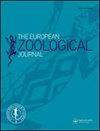放牧对蒙古干旱区陆生节肢动物多样性的影响
IF 1.4
4区 生物学
Q2 ZOOLOGY
引用次数: 0
摘要
节肢动物在草原生态系统中起着重要作用。然而,测试陆生节肢动物对过度放牧的整体反应的研究很少。这个问题在中亚特别令人担忧,而迄今为止,在该地区只进行了很少的更广泛的研究。本文利用陷阱法研究了蒙古东南部两个生态区陆生节肢动物群落结构对不同家畜放牧压力的响应。我们还评估了哪些类群可以作为最有效的放牧强度指标。结果表明,生境类型、放牧强度及其交互作用对物种组成和丰度有显著影响。然而,放牧强度对两个生态区节肢动物群落组成的影响不同。与半荒漠生境相反,在草原生境中,放牧对中度放牧地的影响最大。这很可能是因为草原物种对植物生物量的损失和栖息地结构的变化更为敏感。我们还发现,不同类群中最具代表性的物种对放牧强度变化的反应不同,这表明它们的存在表明了各自栖息地的特征。在制定受保护物种的管理计划时,以及在不同生境类型中实施放牧管理时,也应考虑到这种差异。我们的调查是中亚地区最全面的调查之一,应该有助于在相应的栖息地进行进一步的、更有针对性的研究。在草甸草原和其他干旱生境中,放牧牲畜是荒漠化的最严重原因之一,导致植被覆盖、植物物种丰富度和地上生物量的总体下降,因此往往对节肢动物多样性产生负面影响。尽管放牧对节肢动物多样性的影响已经成为众多研究的主题,但其中大多数只关注单一或少数节肢动物,并且是在中亚以外进行的(例如,只有一篇论文涉及在蒙古进行的几个节肢动物群体的分析,蒙古超过40%的人口依赖于畜牧生产,其高达90%的领土属于各种干旱地区)。我们假设不同节肢动物类群的总体多样性会随着放牧强度的变化而变化,这些变化取决于生境类型,并且在节肢动物类群之间存在差异。结果表明,生境类型、放牧强度及其相互作用对物种组成和丰度有显著影响。研究结果表明,不同的陆生节肢动物类群和最丰富类群的代表物种对放牧强度变化的反应不同,在制定保护物种管理计划和在不同生境类型中实施放牧管理时应考虑这种差异。研究结果还表明,单凭物种多样性不能反映物种组成随放牧强度的变化,在研究放牧对干旱生境的影响时,还应考虑特定物种的个体需求。本文章由计算机程序翻译,如有差异,请以英文原文为准。
Impact of livestock grazing on the terrestrial arthropod diversity in the arid zone of Mongolia
Abstract Arthropods play an essential role in steppe ecosystems. However, studies testing the overall response of terrestrial arthropods to overgrazing are scarce. The problem is particularly worrisome in Central Asia, while, to date, only a very few broader studies have been conducted in this region. We investigated how epigeic terrestrial arthropod assemblages respond to different livestock grazing pressure in two ecozones in SE Mongolia by examining their structure using pitfall traps. We also assessed which groups can be utilised as the most efficient indicators of grazing intensity. Our analyses demonstrated that the habitat type, grazing intensity, and the interaction of these variables had a significant effect on the overall species composition and abundance. However, the grazing intensity caused different changes in the composition of arthropod communities in both studied ecozones. Contrary to the semi-desert, in the steppe habitat, the grazing had the strongest impact in the moderately grazed site. It is most likely because steppe-dwelling species are more sensitive to loss of plant biomass and changes in habitat structure. We also found that the most representative species within and from different groups can react differently to changing grazing intensities, indicating with their presence the characteristics of the respective habitat. Such differences should also be considered when elaborating the management plan of conserved species but also when applying grazing management in different habitat types. Our survey is one of the most comprehensive in Central Asia and should help implement further, more targeted studies in the corresponding habitats. Key policy highlights In meadow steppes and other arid habitats, livestock grazing is one of the most severe causes of desertification and leads to an overall decline in vegetation cover, plant species richness and aboveground biomass, and, consequently, most often negatively affects arthropod diversity. Although the impact of grazing on arthropod diversity has already been the subject of numerous studies, most of them were focused only on a single or small number of arthropods and were conducted outside Central Asia (e.g., there is only one paper dealing with analyses of several arthropod groups conducted in Mongolia, where over 40% of the human population depends on pastoral livestock production and up to 90% of its territory belongs to various arid areas). We hypothesise that the overall diversity of different arthropod groups will change according to the grazing intensities, and these changes will depend on the habitat type and will differ between arthropod groups. Our analyses demonstrated that the habitat type, grazing intensity, and the interaction of these two variables significantly impacted the overall species composition and abundance. Our results highlight that the different terrestrial arthropod groups and representative species of the most abundant groups can react differently to changes in grazing intensity, and such differences should be considered when elaborating the management plan of conserved species and when applying grazing management in different habitat types. Our results also highlight that the species diversity alone cannot indicate the changes in species composition along the grazing intensity, and one should also consider the individual needs of specific species while investigating the impact of grazing on arid habitats.
求助全文
通过发布文献求助,成功后即可免费获取论文全文。
去求助
来源期刊

European Zoological Journal
Agricultural and Biological Sciences-Animal Science and Zoology
CiteScore
3.10
自引率
5.60%
发文量
80
审稿时长
30 weeks
期刊介绍:
The European Zoological Journal (previously Italian Journal of Zoology) is an open access journal devoted to the study of all aspects of basic, comparative and applied protozoan and animal biology at molecular, cellular, tissue, organ, organismal, population, and community-ecosystem level. Papers covering multiple levels of organization and integrative approaches to study animal form, function, development, ecology, evolution and systematics are welcome. First established in 1930 under the name of Il Bollettino di Zoologia, the journal now has an international focus, reflected through its global editorial board, and wide author and readership.
 求助内容:
求助内容: 应助结果提醒方式:
应助结果提醒方式:


